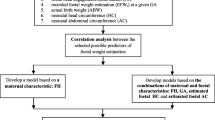Abstract
Objective
To evaluate the factors associated with low birth weight (LBW) and to formulate a scale to predict the probability of having a LBW infant.
Methods
This hospital based case–control study was conducted in a tertiary care university hospital in North India. The study included 250 LBW neonates and 250 neonates with birth weight ≥2,500 g. Data were collected by interviewing mothers using pre-designed structured questionnaire and from hospital records.
Results
Factors significantly associated with LBW were inadequate weight gain by the mother during pregnancy (<8.9 kg), inadequate proteins in diet (<47 g/d), previous preterm baby, previous LBW baby, anemic mother and passive smoking. The prediction model made on these six variables has a sensitivity of 71.6 %, specificity 67.0 %, positive LR 2.17 and negative LR of 0.42 for a cut-off score of ≥29.25. On validation, it has a sensitivity of 72 % and specificity of 64 %.
Conclusions
It is possible to predict LBW using a prediction model based on significant risk factors associated with LBW.

Similar content being viewed by others
References
UNICEF. The state of the world’s children 2008. United Nations Children’s Fund. 2007. http://www.unicef.org/sowc08/docs/sowc08.pdf. Accessed on 1 Jan 2013.
NNF. National neonatal perinatal database- Report 2002–2003. National Neonatology Forum, India. 2005. http://www.newbornwhocc.org/pdf/nnpd_report_2002-03.PDF. Accessed on 3 Jan 2013.
Department of Women and Child Development, Ministry of Human Resource Development. National Nutrition Policy. Government of India. 1993. http://wcd.nic.in/nnp.pdf . Accessed on 3 Jan 2013.
Reeb KG, Graham AV, Zyzanski SJ, Kitson GC. Predicting low birth weight and complicated labor in urban black women: A biopsychosocial perspective. Soc Sci Med. 1987;25:1321–7.
Sharma MK, Kumar D, Huria A, Gupta P. Maternal risk factors of low birth weight in Chandigarh, India. Internet J Health. 2009;9. doi:10.5580/10f1
Khan N, Jamal M. Maternal risk factors associated with low birth weight. J Coll Physicians Surg Pak. 2003;13:25–8.
Badshah S, Mason L, Mckelvie K, Payne R, Lisboa PJ. Risk factors for low birth weight in the public-hospitals at Peshawar, NWFP-Pakistan. BMC Publ Health. 2008;8:197.
Ullah MA, Haque MJ, Hafez MA, Khanam M. Biological risk factors of low birth weight in rural Rajshahi. J Teachers Assoc. 2003;16:50–3.
Vega J, Saez G, Smith M, Agurto M, Morris NM. Risk factors for low birth weight and intrauterine growth retardation in Santiago, Chile. Rev Med Chil. 1993;121:1210–9.
Mavalankar DV, Trivedi CC, Gray RH. Maternal weight, height and risk of poor pregnancy outcome in Ahmedabad, India. Indian Pediatr. 1994;31:1205–12.
Deshmukh SS, Motghare DD, Zodpey SP, Wadhva SK. A study of low birth weight and associated maternal factors in urban area. Indian Pediatr. 1998;35:7–10.
Deswal BS, Singh JV, Kumar D. A study of risk factors of low birth weight. Indian J Community Med. 1999;24:127–31.
de Boo HA, Harding JE. The developmental origins of adult disease (Barker) hypothesis. Aust N Z J Obstet Gynaecol. 2006;46:4–14.
Kramer MS. Determinants of low birth weight: Methodological assessment and meta-analysis. Bull World Health Organ. 1987;65:663–737.
Mohan M, Prasad SR, Chellani HK, Kapani V. Intrauterine growth curves in north Indian babies: Weight, length, head circumference and ponderal index. Indian Pediatr. 1990;27:43–51.
UNICEF/WHO. Antenatal care in developing countries: Promises, achievements and missed opportunities. World Health Organization. 2003. http://www.childinfo.org/files/antenatal_care.pdf. Accessed on 4 Jan 2013.
WHO. WHO antenatal care randomized trial: Manual for the implementation of the new model. World Health Organization. 2002. http://whqlibdoc.who.int/hq/2001/WHO_RHR_01.30.pdf. Accessed on 4 Jan 2013.
Deshmukh JS, Motghare DD, Zodpey SP, Wadhva SK. Low birth weight and associated maternal factors in an urban area. Indian Pediatr. 1998;35:33–6.
Humphreys RC. An analysis of the maternal and fetal weight factors in normal pregnancy. J Obstet Gynaecol Br Emp. 1954;61:764–71.
Kumar N, Shekhar C, Kumar P, Kundu AS. Kuppuswamy’s socioeconomic status scale-updating for 2007. Indian J Pediatr. 2007;74:1131–2.
National Institute of Nutrition. Nutrient requirements and recommended dietary allowances for Indians. Indian Council of Medical Research. 2010. http://icmr.nic.in/final/RDA-2010.pdf. Accessed on 2 Jan 2013.
Zimmer-Gembeck MJ, Helfand M. Low birth weight in a public prenatal care program: Behavioral and psychosocial risk factors and psychosocial intervention. Soc Sci Med. 1996;43:187–97.
Contributions
AS, SA, HC and KA: Conception and design, analysis and interpretation of data, drafting the manuscript, critical revision of the manuscript for intellectual content and final approval of the version to be published; RP: Statistical analysis.
Conflict of Interest
None.
Role of Funding Source
None.
Author information
Authors and Affiliations
Corresponding author
Rights and permissions
About this article
Cite this article
Singh, A., Arya, S., Chellani, H. et al. Prediction Model for Low Birth Weight and its Validation. Indian J Pediatr 81, 24–28 (2014). https://doi.org/10.1007/s12098-013-1161-1
Received:
Accepted:
Published:
Issue Date:
DOI: https://doi.org/10.1007/s12098-013-1161-1




